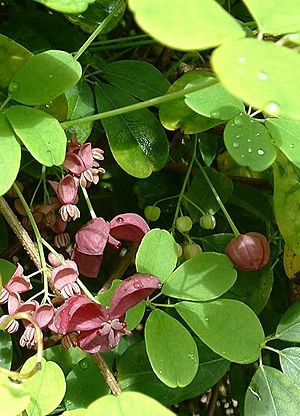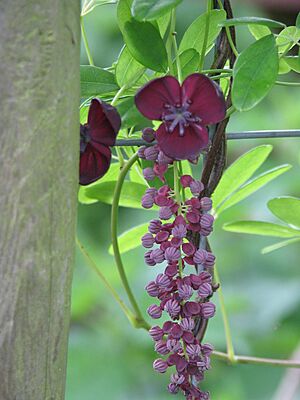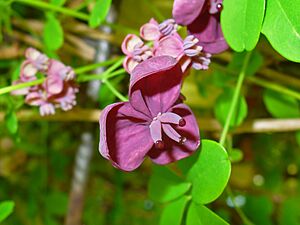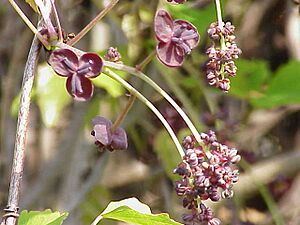Akebia facts for kids
Quick facts for kids Akebia |
|
|---|---|
 |
|
| Akebia quinata | |
| Scientific classification |
|
| Kingdom: | Plantae |
| Clade: | Tracheophytes |
| Clade: | Angiosperms |
| Clade: | Eudicots |
| Order: | Ranunculales |
| Family: | Lardizabalaceae |
| Genus: | Akebia Decne. |
| Species | |
|
See text. |
|
Akebia is a group of five different kinds of flowering plants. They belong to a plant family called Lardizabalaceae. The scientific name, akebia, comes from the Japanese word for the Akebia quinata plant, which is akebi (通草).
Contents
What Are Akebia Plants?
Akebia plants are usually vines that grow and climb. They are known for their interesting flowers and sometimes for their edible fruits. There are five main types, or species, of Akebia plants found in different parts of Asia.
Different Types of Akebia
There are five known species of Akebia:
- Akebia apetala: This type is found in China, Japan, Korea, and Taiwan.
- Akebia chingshuiensis: This species grows only in Taiwan.
- Akebia longeracemosa: You can find this plant in China and Taiwan.
- Akebia quinata: Also known as the Chocolate vine or five-leaf akebia. It grows in China, Korea, and Japan.
Mixed Akebia Plants
Sometimes, two different types of Akebia plants can cross-pollinate and create a new, mixed plant. This is called a hybrid. One example is Akebia ×pentaphylla, which is a mix of A. quinata and A. trifoliata.
Akebia Fruit: A Sweet Treat
Two types of Akebia, Akebia quinata and Akebia trifoliata, grow fruit that you can eat. The fruit has a sweet, white, jelly-like inside.
What Does Akebia Fruit Taste Like?
The taste of Akebia fruit can be quite different from one plant to another, even within the same type. Some people say it tastes like a mix of banana, passionfruit, and lychee. Others find it to be mild or not very flavorful.
Akebia in Japanese Culture
Akebia plants are often mentioned in Japanese literature. They remind people of peaceful countryside scenes. While the word akebi usually means the five-leafed type, the three-leafed type is also used in similar ways.
Akebia as Food in Japan
In the past, Akebia fruit was a minor food that people would find while looking for wild plants. Today, it's seen as a special seasonal food. The fruit pods hold a white, clear, jelly-like pulp that is mildly sweet and full of seeds. Some people remember fondly how they used to pick these fruits in the hills when they were kids.
The purple skin of the fruit is a bit bitter. It's sometimes cooked as a vegetable, especially in Yamagata Prefecture in northern Japan. A common recipe involves stuffing the rind with minced chicken or pork, seasoned with miso. Small amounts of Akebia fruit are sent to cities as a unique vegetable.
Other Uses for Akebia
Besides eating the fruit, the leaves of Akebia plants can be used to make a tea. The strong vines of Akebia are also used to weave baskets and other crafts. Places like Minakuchi and Tsugaru (now part of Aomori Prefecture) were known for making baskets from the vines of the three-leafed Akebia.
Gallery
See also
 In Spanish: Akebia para niños
In Spanish: Akebia para niños










